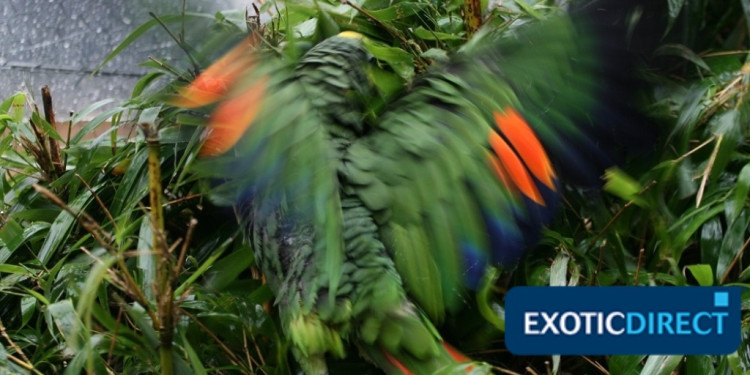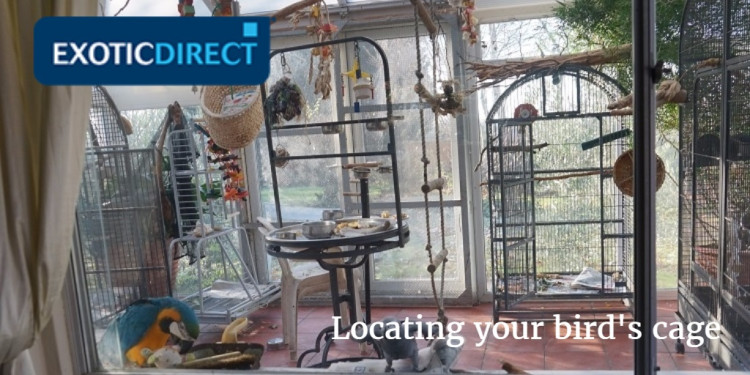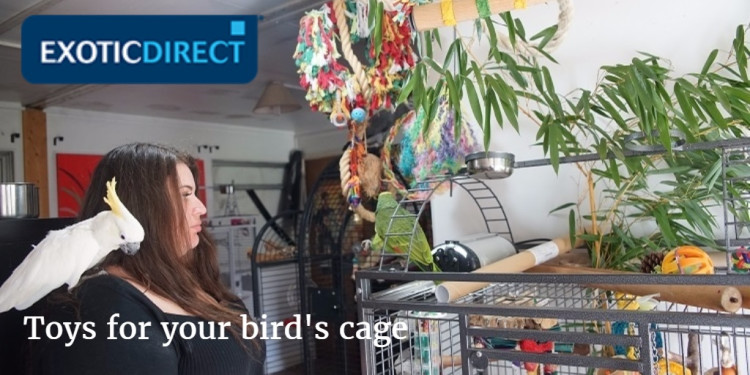A new bird is arriving – maybe to join one you already have. And the big question is what sort of cage? The available choice can be bewildering. This article helps you set your bird’s cage up.
Insure your small bird for £1,500 of vet fees | Get a quote | We can insure Budgerigars, Canaries, Love Birds, Cockatiels, Finches and more | We’ve been insuring exotic pets since 1996 | Check out our customer reviews on Feefo.
What kind of bird cage do I need? | What kind of spacing between the bars do I need? | Where should I locate my birds cage? | How to keep pets away from parrots | What should I line the cage with? | UV lighting and my bird | What kind of perch do I need? | Where to put the food and water bowls | Parrot toys
Bar spacing, where to put the perches, what about toys and UV? We answer the questions you have when it comes to setting up your bird cage. So that your bird’s cage is not only her home, but her castle.
What kind of bird cage do I need?
A cage is a home and a territory – it shouldn’t be a cell – so the larger the better for your bird type.
The best cages are made of stainless steel but for most of us they are too costly. With a modern cage, you don’t need to worry about lead in any of the construction.
What kind of spacing between the bars do I need?
African Greys, Caiques, larges Conures Amazon, Eclectus, and small Macaws or mini Macaws can be in a cage with a bar spacing of around 20-24mm.
Bar spacing can vary depending on the size of the bird it’s been designed for.
You’ll find that larger cages have wider spacing – this should be remembered if you’re planning to put a small bird in it. There have been accidents where a small bird pushes a wing through and injures it or even breaks it.
If you’ve got a larger cage and you feel the spacing is too wide, you’ll need to attach a smaller mesh wire inside or outside.
I think that cages for smaller birds are too small. This is rather a minority view.
Another article you may like: Safe food and plants list for parrots.
 A parrot enjoying the rain in her aviary. Read about the importance of water.
A parrot enjoying the rain in her aviary. Read about the importance of water.
Where should I locate my birds cage?
A cage can be placed in the living area or in the kitchen (if you are confident of never burning saucepans and emitting dangerous fumes.)
I’d always recommend a cage on wheels (modern cages already are). You can also put your cage on a wheeled trolley, so that you can move your bird from one location to another.
If you don’t have an aviary, you can wheel the cage into the garden or on a balcony.
The cage should stand in a corner or have the back against an internal wall so that the bird can retreat from view if she wants to.
You should avoid draughts. Pet parrots can withstand cold but dryness or draughts can cause illness.
Putting a cage for single bird in a corridor or garage or bedroom is unjustified and unkind.
Direct sunlight on the cage even through glass is to be avoided.
Many parrots enjoy a view from the window and will comment on passing wild birds that they see.
Chaucer, my friend Virginia’s African Grey calls out ‘Squirrel, squirrel,’ whenever he sees them in the yard.
Some carers have sleep cages in a quiet room, where the parrots are taken each night so that in the daytime, they can interact with the family.
Finally, you can also adapt a whole room to your bird. However, your bird will need the company of other birds for this, unless you plan to spend all your time in there.
 Birds in a bird room – with the company of other birds and entertainment
Birds in a bird room – with the company of other birds and entertainment
How to keep pets away from parrots
An adult bird coming first into contact with domestic cats or dogs can be seriously frightened. Without a long period of desensitisation and acclimatisation, there’s not much else you can do but keep them apart.
The problem is not insuperable but can be tricky. When my four-year-old niece ignored my warning not to put her fingers in Casper’s cage, he nipped her; she learned the hard way.
In 20 years, I’ve co-existed with parrots, dogs, cats, poultry, horses, children and grandchildren. If puppies and kittens are brought up with parrots they accept them as part of the household. But parrots DO bite and if the very idea of this is something you dislike then a parrot isn’t a suitable pet.
However, in the same way that a farm dog won’t attack the farmyard free range hens, a pet dog or cat can become accustomed to living alongside flighted companions.
I’d never allow different species loose in a space together unsupervised. That said, my husband Wal and I generally watch TV with two or three assorted pets. Many of my friends do the same.
You may also like to read this Training your parrot to ‘step up’
What kind of perch do I need?
A good quality cage comes with at least one wooden perch. Wood is undoubtedly the best material for perches.
I discard any plastic ones. You will want to add one or two extra perches so the bird has possibility to climb around or flutter from one to the other.
Birds like to be as high as possible so if the main perch crosses between the food bowls, put subsidiary perches at angles as high as possible.
I use tree branches and cut a notch at each end so that they slot into the bars. Of the commercial perches available, nail trimming perches work well in wearing down claws obviating the need for clipping.
Wooden perches will get chewed and need replacing frequently. There are also edible perches and mineral perches available. Bendy rubber or rope perches are fun.
Bear in mind the size of the birds’ claws; the smaller species need thinner perches – the larger need wider ones. A variety of diameters helps maintain healthy feet and claws.
Cost of perches varies enormously well washed tree branches come free. A flat perch can be a comfort for any bird with sore feet or arthritis.
Where to put the food and water bowls in the cage
Most cages come with two bowls attached and a perch stretching across the middle of the cage. You may want to hang some additional bowls on the bars.
When buying new bowls, stainless steel will amply repay the extra cost in the ease of keeping clean and lasting permanently. Plastic bowls get greasy; ceramic bowls crack and break.
What should I line the bottom of my birds cage with?
Using wood shavings on hard floor looks attractive, if you are sure the wood is natural and contains no chemicals.
The same for corn husks. We are a newspaper family so always have newspaper for lining.
Brown paper sheets look smart. If you like cleaning, you actually don’t need any lining but will then have to wash the grill and base daily.
What toys can I put in my bird’s cage?
One of the best toys to keep bird’s active is some sort of swing. You can also use your ingenuity and make toys of your own. I’ve written an article on making toys here.
Inspect toys regularly, frayed rope can be dangerous. Toys that offer a challenge like the best foraging ones, can keep a bird content for a long time.
Internet suppliers and pet shops have an astonishing variety of toys. I also use charity shops. I say that if an object has a child safe label it will also be bird safe.
A good idea is to have a toy box so that you can rotate toys to prevent boredom and stimulate curiosity.
A well-brought up young bird displays curiosity and plays naturally with toys. A bird that has become phobic may need desensitizing to toys. Leave a new toy outside a cage until the bird grows used the sight of it.
Finally, don’t expect your toys to last. I find it hard to believe that Benni macaw has actually chewed through what I thought was an indestructible plastic ball.
 Your bird should have a variety of toys to stimulate them.
Your bird should have a variety of toys to stimulate them.
Why does my bird need UV lighting?
Birds need Vitamin D (as we do) from sunlight. Indoor birds can obtain it from UV lighting.
When my friend Natalie adopted Dave, a dull-feathered, traumatised Blue fronted Amazon, his feathers dramatically improved as did his sinusitis when she placed a UV light on top of his cage.
The importance of water and humidity for your bird
Like us mammals, birds cannot survive without water. Water bowls that must be changed once or twice a day if the parrot dunks her food. I use tap water or rain water and add a teaspoon of cider vinegar to a litre. Cider vinegar is supposed to confer health benefits.
None of my flock – except Casper Grey- enjoy being sprayed. They bathe themselves in a stainless-steel bowl in the bird room or and a similar one in the aviary.
If you use fresh branches that are wet with rain, most birds will enjoy playing in them. Many people take their birds into the shower with them as a daily routine.
Just remember not to wet a bird too late in the day as the feathers must be dry before sunset. Cockatoos can adore hair dryers.
Do birds need to be covered at night?
Companion carers who do cover believe that it gives a bird a more restful night and a sense of routine. A nervous bird can be reassured.
I believe a cover used to quieten a screaming bird is unkind and unproductive.
Many parrots enjoy being covered and will say ‘night-night’ and eagerly ‘good morning’ when it’s time for the cover to be removed.
I‘d never cover a bird for more than 12 hours because that is their natural rhythm wired into their brains. I’ve never used covers myself.
How much time should parrots spend out of their cage?
Your bird will need 3 – 4 hours minimum out of cage time.
Ask yourself if you have you got enough time and space for the type of bird you have chosen? Keeping a bird in a cage 24/7 is unkind. They need exercise and your presence.
Out-time is essential to keep a creature as intelligent as a parrot interested and not prone to develop screaming and biting and plucking behaviours or else simply become apathetic and bored.
Exercising your bird
As mentioned, out time should be 3 – 4 hours minimum for a bird’s mental and physical health. If you work during the day my article on parrot care suggests a workable routine.
Small birds like budgies and cockatiels get exercise in a flat or house.
The larger species benefit from a screened in patio or an aviary in the garden.
A play gym on top of the cage can be a worthwhile activity for everyone. They play and you observe.
Is your small bird insured? Get a quote for £1,500 of vet fees. | We can insure Budgerigars, Canaries, Love Birds, Cockatiels, Finches and more | We’ve been insuring exotic pets since 1996 | Check out our customer reviews on Feefo.
ResourcesNot all pet shops have knowledgeable salespersons. Two internet sites I have used which have very helpful advisers if you phone or email them are:
www.northernparrots.com Tel: 0800 488 0345 or 01706 507309
info@northernparrots.com.
and www.gardenfeathers.com Tel 0191 5277025 Email: info@gardenfeathers.co.uk
The Parrot Society UK (if you have a parrot – join) will answer any husbandry question.
Tel: 01442 872245 Email. les.rance@theparrotsocietyuk.org

